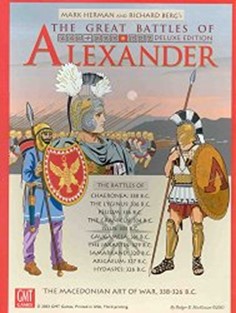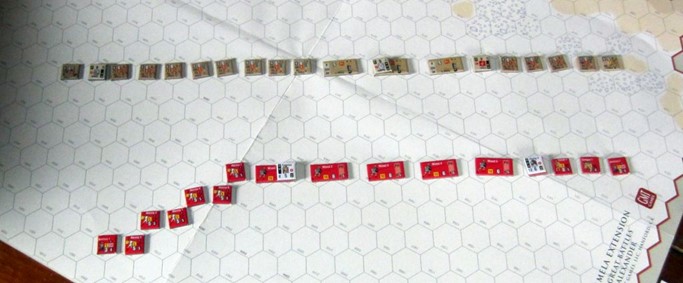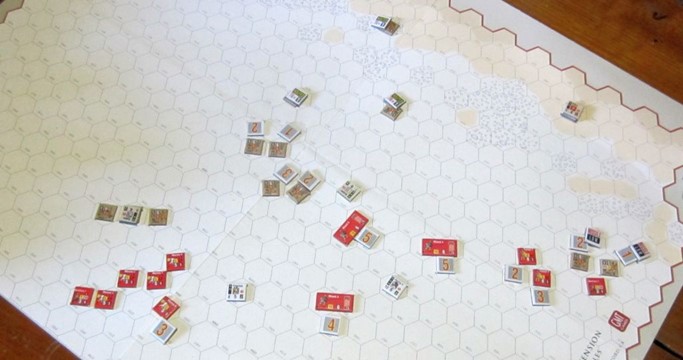 The Erigon Valley. Upper Macedonia. 358 BC.
The Erigon Valley. Upper Macedonia. 358 BC.
Philip had ascended the throne of Macedon the year before after his brother, Perdiccas III had been killed by King Bardylis of Illyria. Bardylis had been an ongoing thorn in the side of the Macedonians: he’d defeated Philip’s father as well and occupied most of Macedonia. The next year, Philip II of Macedon decided enough was enough and marched to deal with the pesky Illyrian once and for all.
Welcome to an After Action Report (AAR) of the latest edition of The Great Battles of Alexander, which came out earlier this year. The Great Battles of History series is one the few Ancients war-games I play, but it’s a series I really enjoy. The first title in the series was Alexander, which has moved to a fifth edition with this release. The box is bigger, and it includes three expansions as well as a few new scenario. This particular scenario is one of the new ones: one of the major battles that Alexander’s father, Philip, participated in.
I played this game solitaire. It’s probably better to play with a friend, but the GBoH series plays pretty well solo. (There are other games, such as full Advanced Squad Leader, where there’s a lot of hidden information and I prefer to play them with friends.)
The big question is this: How historical is it? Well, not all that much. The system may represent how to resolve historical conflicts well, but it can only do that as well as the data we feed into it. And we know almost nothing about this battle. We know it occurred. We know a few of the tactics that were used. But we certainly don’t have an accurate data on how many people were fighting and how they were armed. So, the designers have given it their best shot. This scenario originally appeared in C3i Magazine #13 and was by Stephen Jackson; the developer was (most likely) Alan Ray.
It’s a fairly simple scenario: each force has just a few counters, there are a handful of leaders, and the sides will withdraw once they lose 40 “rout points”. I wasn’t expecting a long scenario, and it lived up to that expectation. It’s a good one to get back into the hang of the system – or to learn the system for the first time.
Here’s how the set-up of the scenario looks:

For the purposes of this scenario, we’re ignoring all the terrain: it’s just a flat battlefield somewhere in Upper Macedonia. Philip II’s forces are in red at the bottom of the map and Bardylis’s troops are the other ones towards the top. Unusually, Philip has set up his troops so that his cavalry and skirmishers on the left are set back to protect the left flank from attack. Phalanxes have a lot of trouble fighting cavalry when they’re facing the wrong way!
It feels odd to go back to Alexander after playing the most recent volumes in the series, Chariots of Fire and Hoplite. The way you activate troops in this early game is quite unusual, and there are times when it just doesn’t properly work.
Newer titles arrange troops in commands – when you activate a command, all the troops in that command move and attack. In Alex, each leader can activate a finite number of individual troop counters. As a result, there are battles where some of the troop counters stay behind and don’t move! This is one of those battles. (Later battles in the game allow Line commands, which at least allow groups to enter battle together).
The other thing – and this is something I did when playing this scenario – is that once a leader enters shock combat, he’s trapped there unless the Overall Commander retrieves him or his opponents die. The biggest problem here is that the leader doesn’t get to give movement commands to his other troops – so any that need to be rallied or called to advance just won’t. This is a bad thing. On the other hand, at least he gives a die roll modifier to the battle he’s in! I think it would have been a much better idea this battle to keep my leaders back a bit.
The lesser leaders in this battle are the two flank commanders of the Illyrians, Grabos and Clitus. Grabos, on the right flank of the Illyrian line, sent forward some of his light and medium infantry and skirmishers to engage the Macedonian line (or to prepare for H&D – Harrassment and Dispersal fire), while staying back himself – he didn’t have enough commands to advance everyone. Clitus advanced with his troops to directly engage the right flank of the Macedonians; some of the Macedonian cavalry retreated as they advanced, but most of the line held firm – they paid for it as well, taking quite a few cohesion hits along the way.
Parmenion, Philip’s commander of the left flank, pushed back hard. The phalanxes he controlled inflicted quite a bit of damage on the Illyrian troops, and two of their units turned and ran – as did one of the Macedonian phalanxes, him with it! Parmenion tried to activate again using the Momentum rules, but failed.
(Each leader has an initiative value, and leaders activate from lowest to highest, alternating between players if there are several leaders with the same initiative score. After a leader finishes activating, it can attempt to activate again by rolling equal or lower than its initiative on the die – a d10. However, if it succeeds, the opponent can try to “trump” the activation by making its own die roll with a leader with an equal or better initiative. The Macedonians tend to have better leaders than their opponents, and this ability to trump and make fairly reliable momentum checks can be decisive).
Now it was time for Bardylis to bring up his hoplites. Although they’re double-size counters like the phalanxes, they weren’t quite as effective. That said, it’s not much of a difference, and the initial attack was extremely good for the hoplites, dealing a lot of damage to the Macedonians, routing one of their phalanxes!
Philip activated last, and pushed back, breaking a hole in the line in front of him. Activating again, he brought up his heavy cavalry to punish the Illyrians, and also managed to rally his fleeing phalanx. A fair number of Illyrian troops now tried to flee the battlefield, and both sides had taken a fair amount of damage.
At the end of the first turn, here’s how the battlefield looked:

Troops in Alexander are rated by troop type and Troop Quality, which typically goes from 3 to 8. (There’s also a size value, which is of limited relevance). As troops engage in combat and take damage, they take Cohesion Hits. Once a troop counter has hits equal to its TQ, it routs. Phalanxes have a chance of not routing, based on a die roll. Determining combat results depends on troop types and from where they’re attacked, the TQ indicates how long they’ll stay on the battlefield.
In the picture, I’ve got the cohesion hits set next to (rather than atop or underneath) the troop counters. There are also markers for Routed units and for units who have run out of missiles (or are merely low). Javelin-armed troops that enter shock combat use their javelins immediately and should be marked Missile No, but I rarely do so, preferring not to clutter up the battlefield and just remember their status.
A battle ends when a side loses a certain number of rout points – 40, in this case, for both sides. Generally, a unit is worth its TQ in rout points, although double-sized units are worth twice that. By the end of the first turn, the Macedonians had lost one phalanx, which had routed away and so were on 12 of 40 rout points. The Illyrians had troops running, but they hadn’t left the battlefield yet. They had 0 of 40 rout points, and were looking pretty good. It wasn’t to continue!
The second turn began with Grabos sending up his remaining troops, while Clitus activated the troops around him in shock combat. It was a bloody affair, and units on both sides began to turn and run – in one case, the routing unit ran straight at a friendly unit, which also turned and joined the rout!
Pergamon, finding himself away from the battle in a place where he could influence affairs, started rallying the fleeing Macedonian phalanxes. Unfortunately for the Illyrians, Bardylis was trapped in the battle and unable to do the same. Indeed, as Philip started on the last activations, Bardylis found himself running for his life along with his hoplites, as the Macedonians pushed forward.
Philip pushed his main phalanx forward again – it took a cohesion hit, but stayed together (5 of 6!), and there it engaged two routed hoplite units, destroying them both. It itself began to run, but Philip used his last momentum activation to rally it and those others of the troops that were still on the battlefield. He wasn’t always successful – a couple of really bad rolls eliminated a pair of units, including a phalanx – but he was successful enough.

The Macedonians had lost 36 points of troops – they had only 4 remaining before they lost. However, that exceedingly bloody turn had seen the Illyrians lose all 40 of their Rout points – in fact, 45 in total! Three hoplite, one medium infantry and two light infantry counters.
It had been a narrow victory, but Philip II would take it!
There’s little doubt that the fact the Illyrian leaders were trapped in combat and unable to rally their troops made a big difference in this scenario. Assuming I find the time to continue playing through these scenarios, I’ll have to try keeping the leaders back and see how that works.
What happened historically? Philip II won the battle, aided primarily by his heavy cavalry which could attack whilst the phalanxes pinned the hoplites. Apparently 7,000 Illyrians were killed. Yes, each counter represents about 700-1000 men, double that for the phalanxes!

Merric,
Nice AAR mate. One thing -as per Alex rules 9.65 a phalanx cannot be rallied once it routs. Something for next time I suspect from your write up.
Actually, the rule has changed in the 5th edition – you can rally phalanxes again! New rule in 10.27 – the new rules are here: http://www.gmtgames.com/gbad/DelAlex5_Rules_FINAL.pdf